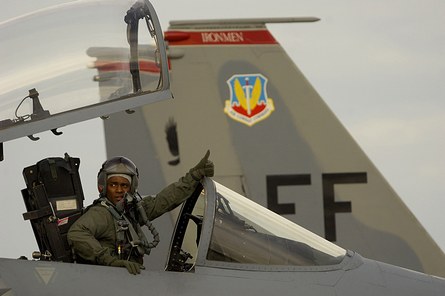US Air Force Boeing F-15 Eagles have begun returning to flight, but the service says it is possible a portion of the fleet will never fly again. Some 40% of the fleet remains grounded, and the USAF continues to push for more Lockheed Martin F-22s to replace its air-superiority F-15s.
"I have a fleet that is 100% fatigued, and 40% of that has bad parts. The long-term future of the F-15 is in question," says Gen John Corley, commander of Air Combat Command. "The problem is systemic and goes beyond the F-15," he says, citing fatigue issues with A-10s and F-16s.

F-15 pilots must now regain currency and proficiency © US Air Force
ACC has cleared 259 of the USAF's 441 F-15A-Ds to return to flight without restrictions after they passed inspections for manufacturing deficiencies that could potentially cause fatigue cracking of forward fuselage longerons.
The inspections followed the 2 November 2007 crash of a Missouri Air National Guard F-15C when the upper right longeron failed during air-combat training, causing the cockpit to separate from the fuselage.
Cracks were found in nine other F-15s where machining during manufacture had reduced the thickness of the longeron web below blueprint specification or where there is surface roughness that could cause stress concentration.

The 40% of the fleet that remains grounded have longerons that do not meet blueprint specification at one or more points, says Maj Gen Thomas Owen, commander of Warner Robins Air Logistics Center, the F-15 depot.
The affected aircraft were delivered between 1972 and 1985 and range from F-15As to F-15Ds. Corley says one of his reasons for grounding the fleet was that the problems did not appear to be restricted to one group of aircraft.
During the inspections, metal thickness was ultrasonically checked at 84 locations on each upper right and left longeron and if any one of the 168 data points was below specification, the aircraft remained grounded, he says.
Affected aircraft are now being analysed individually to determine if they can be returned to service with recurrent inspections or flight restrictions, or whether they must be repaired or scrapped.
An initial batch of 15 new longerons is being produced, Owen says, but the USAF has not decided which aircraft will undergo the repair. The cost to replace a longeron is around $250,000, he says.

© US Air Force
Some of the F-15s are planned to be retired in 2009 as part of a force drawdown, but Corley says fatigue and manufacturing defects "put into huge question" the US Air Force's plan to keep 177 upgraded "Golden Eagles" in service.
"What are we going to have to do to keep them viable?" he says. "We were going to add combat capability to those aircraft, but instead we may have to spend billion on structural upgrades." The planned upgrades include active electronically scanned array radars.
Even before the Eagle broke up in flight, the US Air Force was pressing the Department of Defense for funding to buy additional F-22s beyond the 183 currently planned to replace its F-15s. "Can I buy more F-22s, can I buy F-22s at the rate I need, can I buy F-22s until F-35s are available? All options are on the table," says Corley.
F-15A-Ds are the principal aircraft assigned to the US air sovereignty mission and while they have been grounded the USAF has beeen using F-15Es, F-16s and F-22s. But this is interfering those units' preparations for deloyments to Afghanistan and Iraq, Corley says, adding: "We can only do it for a period of time."
Read the rest of flightglobal's special report on the US Air Force F-15 accident investigation:
VIDEO: USAF reconstructs F-15 accident
VIDEO: Recreating the Eagle's final moments
PICTURES: Manufacturing defects caused crack that downed USAF F-15
BLOG: The Woracle asks - is it all the USAF's fault?
Source: Flight International



















